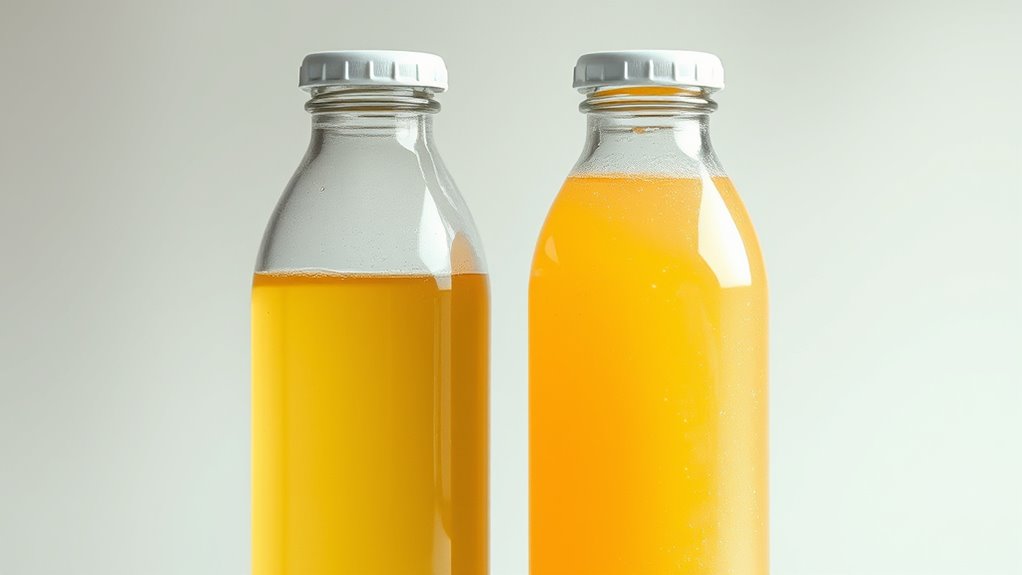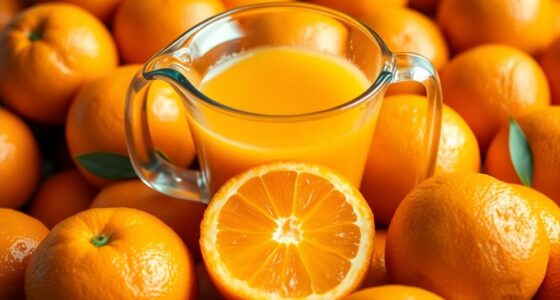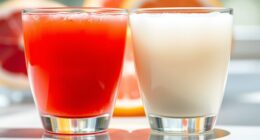When choosing packaging for clarified versus cloudy juice, consider how each product looks and appeals. Clear bottles work best for clarified juice to showcase its transparency and purity, while opaque or semi-opaque containers help protect the pulp and sediment in cloudy juice. Both need packaging that shields against light, heat, and oxygen to uphold freshness. Understanding these differences helps ensure your packaging enhances the product’s appeal and meets consumer expectations—if you explore further, you’ll find even more helpful insights.
Key Takeaways
- Clear bottles showcase clarified juice’s purity, emphasizing transparency and sophistication, while opaque packaging protects cloudy juice’s pulp and sediment.
- Transparent packaging enhances product visibility for clarified juice, highlighting its clarity and vibrant color to attract premium consumers.
- Opaque or semi-opaque containers preserve the natural appearance of cloudy juice, preventing light and oxygen exposure that could degrade quality.
- Packaging design should align with the product’s market positioning—sleek for clarified juice, rustic for cloudy juice—reflecting authenticity or refinement.
- Both juice types require protective packaging to maintain freshness, prevent spoilage, and communicate nutritional benefits effectively.

Have you ever wondered what sets clarified juice apart from cloudy juice? While both types start with the same fruit, the way they’re processed affects not just appearance, but also how they appeal to consumers and what nutritional benefits they offer. Clarified juice undergoes filtration to remove pulp, sediment, and other solids, resulting in a clear, transparent liquid. Cloudy juice, on the other hand, retains much of the pulp and suspended particles, giving it a cloudy or opaque look. This difference influences not only consumer preferences but also the nutritional profile of each product.
Clarified juice is filtered for transparency, while cloudy juice retains pulp, affecting appearance, nutrition, and consumer appeal.
When considering packaging, clarity is a key factor. Clarified juice’s transparency allows for visually appealing bottles that showcase the vibrant color of the juice, which can attract customers seeking purity and cleanliness. Clear bottles tend to highlight the product’s freshness, making them ideal for premium or artisanal brands. Conversely, cloudy juice’s appearance emphasizes its natural, less processed nature, often appealing to consumers who prefer a more rustic or authentic look. Packaging for cloudy juice might include opaque or semi-opaque containers that protect the pulp and sediment, preserving the product’s texture and flavor. Both styles require packaging that safeguards against light, heat, and oxygen, which can degrade quality, but the visual presentation plays a vital role in consumer decision-making. Additionally, understanding filtration and preservation techniques can help maintain product quality during storage and transportation.
Beyond appearance, the nutritional differences influence packaging choices. Clarified juice often has a smoother texture with fewer solids, which may lead consumers to perceive it as more refined or healthier in terms of clarity and ease of drinking. However, cloudy juice typically retains more fiber and beneficial phytochemicals found in pulp and sediment, which can be a selling point for health-conscious buyers. These nutritional differences also impact labeling and marketing strategies, as brands can highlight the presence of fiber or natural pulp to appeal to specific consumer preferences.
Ultimately, your choice of packaging for clarified or cloudy juice hinges on what you want to communicate about your product. Clarified juice’s sleek, transparent packaging emphasizes purity, cleanliness, and sophistication, aligning with consumer preferences for premium quality. Cloudy juice’s packaging, meanwhile, underscores naturalness, authenticity, and nutritional richness. Understanding these distinctions helps you better target your audience and effectively showcase your product’s unique qualities. Whether you prefer the clarity of refined juice or the hearty appeal of its cloudy counterpart, thoughtful packaging can enhance how your juice stands out on shelves and connects with your customers’ desires.
Frequently Asked Questions
How Does Juice Clarity Affect Consumer Preference?
You notice that clear juice often appeals more due to its clean visual appeal, making it seem fresh and pure. This clarity can enhance flavor retention, giving you a better taste experience. Cloudy juice, however, may suggest richness and natural ingredients, attracting those who prefer a more robust flavor. Your preference depends on whether you value a crisp, transparent look or a more vibrant, cloudy appearance that hints at natural goodness.
What Are the Best Packaging Materials for Cloudy Juice?
When it comes to cloudy juice, you wanna go with packaging materials that keep it fresh and appealing. Glass bottles are ideal, offering a sturdy bottle design and excellent preservation, while also being eco-friendly. Consider sustainable packaging options like biodegradable plastics or recycled materials to boost your packaging sustainability. This way, you protect the product and show your commitment to the environment. Remember, it’s all about catching the eye and doing right by Mother Earth.
Does Juice Clarity Influence Shelf Life and Storage?
Yes, juice clarity can influence shelf life and storage. Filtration affects stability, as clarified juice often has fewer particles that can spoil faster, while cloudy juice may contain more enzymes and solids that impact preservation. Packaging innovations, like oxygen barriers and UV protection, help extend shelf life regardless of clarity. Properly selecting packaging materials based on juice clarity guarantees better preservation, quality, and longer storage life.
Are There Specific Labeling Requirements for Clarified and Cloudy Juices?
Ever wondered about labeling requirements for your juices? You’ll need to follow specific labeling regulations that include clear allergen declarations, especially if the juice contains potential allergens like nuts or gluten. Both clarified and cloudy juices must have accurate ingredient lists, nutritional info, and expiration dates. Proper labels help consumers make informed choices and stay compliant with food safety laws. So, always double-check your labeling to avoid legal issues.
How Does Packaging Impact Juice Quality During Transportation?
You should choose packaging innovations that protect juice from light, oxygen, and temperature fluctuations, which can degrade quality during transportation. Proper packaging enhances transportation logistics by preventing leaks, contamination, and spoilage. Using airtight, durable containers with insulating features guarantees the juice remains fresh. Investing in smart packaging solutions can also help monitor conditions throughout transit, maintaining high quality from source to shelf.
Conclusion
Ultimately, your choice between clarified and cloudy juice depends on your preference and purpose. Remember, clarity creates confidence, but complexity offers character. Whether you favor the finesse of filtered freshness or the richness of unfiltered uniqueness, make your decision deliberately. Don’t dismiss the diversity; discover the difference. Embrace the elements, evaluate the essence, and enjoy every sip with mindful meaning. Your perfect pour is simply a matter of mindful measurement and meaningful preference.
Cindy thoroughly researches juicing trends, techniques, and recipes to provide readers with practical advice and inspiration. Her writing style is accessible, engaging, and designed to make complex concepts easy to understand. Cindy’s dedication to promoting the advantages of juicing shines through her work, empowering readers to make positive changes in their lives through the simple act of juicing.











